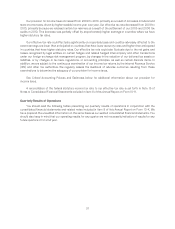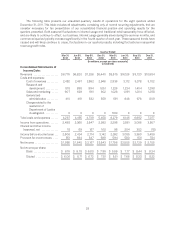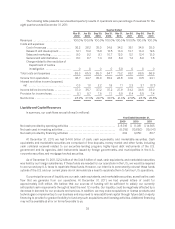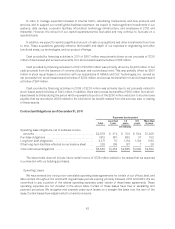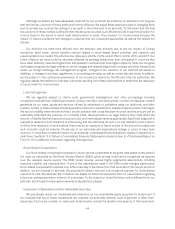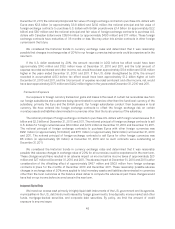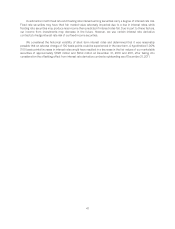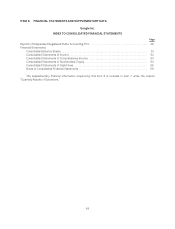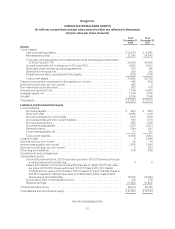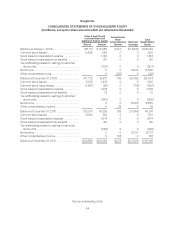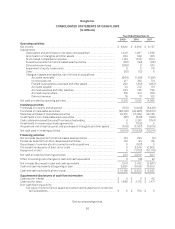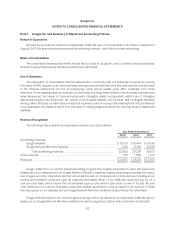Google 2011 Annual Report Download - page 75
Download and view the complete annual report
Please find page 75 of the 2011 Google annual report below. You can navigate through the pages in the report by either clicking on the pages listed below, or by using the keyword search tool below to find specific information within the annual report.December 31, 2011, the notional principal and fair value of foreign exchange contracts to purchase U.S. dollars with
Euros were €2.8 billion (or approximately $3.8 billion) and $232 million; the notional principal and fair value of
foreign exchange contracts to purchase U.S. dollars with British pounds were £1.4 billion (or approximately $2.2
billion) and $80 million; and the notional principal and fair value of foreign exchange contracts to purchase U.S.
dollars with Canadian dollars were C$504 million (or approximately $490 million) and $17 million. These foreign
exchange contracts have maturities of 36 months or less. We may enter into similar contracts in other foreign
currencies in the future.
We considered the historical trends in currency exchange rates and determined that it was reasonably
possible that changes in exchange rates of 20% for our foreign currencies instruments could be experienced in the
near term.
If the U.S. dollar weakened by 20%, the amount recorded in AOCI before tax effect would have been
approximately $140 million and $132 million lower at December 31, 2010 and 2011, and the total amount of
expense recorded as interest and other income, net, would have been approximately $134 million and $138 million
higher in the years ended December 31, 2010 and 2011. If the U.S. dollar strengthened by 20%, the amount
recorded in accumulated AOCI before tax effect would have been approximately $1.2 billion higher at both
December 31, 2010 and 2011, and the total amount of expense recorded as interest and other income, net, would
have been approximately $175 million and $202 million higher in the years ended December 31, 2010 and 2011.
Transaction Exposure
Our exposure to foreign currency transaction gains and losses is the result of certain net receivables due from
our foreign subsidiaries and customers being denominated in currencies other than the functional currency of the
subsidiary, primarily the Euro and the British pound. Our foreign subsidiaries conduct their businesses in local
currency. We have entered into foreign exchange contracts to offset the foreign exchange risk on certain
monetary assets and liabilities denominated in currencies other than the local currency of the subsidiary.
The notional principal of foreign exchange contracts to purchase U.S. dollars with foreign currencies was $1.0
billion and $2.3 billion at December 31, 2010 and 2011. The notional principal of foreign exchange contracts to sell
U.S. dollars for foreign currencies was $84 million and $472 million at December 31, 2010 and December 31, 2011.
The notional principal of foreign exchange contracts to purchase Euros with other foreign currencies was
€991 million (or approximately $1.3 billion) and €711 million (or approximately $929 million) at December 31, 2010
and 2011. The notional principal of foreign exchange contracts to sell Euros for other foreign currencies was
€6 million (or approximately $8 million) at December 31, 2010 and no such contracts were outstanding at
December 31, 2011.
We considered the historical trends in currency exchange rates and determined that it was reasonably
possible that adverse changes in exchange rates of 20% for all currencies could be experienced in the near term.
These changes would have resulted in an adverse impact on income before income taxes of approximately $20
million and $27 million at December 31, 2010 and 2011. The adverse impact at December 31, 2010 and 2011 is after
consideration of the offsetting effect of approximately $467 million and $503 million from foreign exchange
contracts in place for the months of December 2010 and December 2011. These reasonably possible adverse
changes in exchange rates of 20% were applied to total monetary assets and liabilities denominated in currencies
other than the local currencies at the balance sheet dates to compute the adverse impact these changes would
have had on our income before income taxes in the near term.
Interest Rate Risk
We invest our excess cash primarily in highly liquid debt instruments of the U.S. government and its agencies,
municipalities in the U.S., debt instruments issued by foreign governments, time deposits, money market and other
funds, mortgage-backed securities, and corporate debt securities. By policy, we limit the amount of credit
exposure to any one issuer.
46



